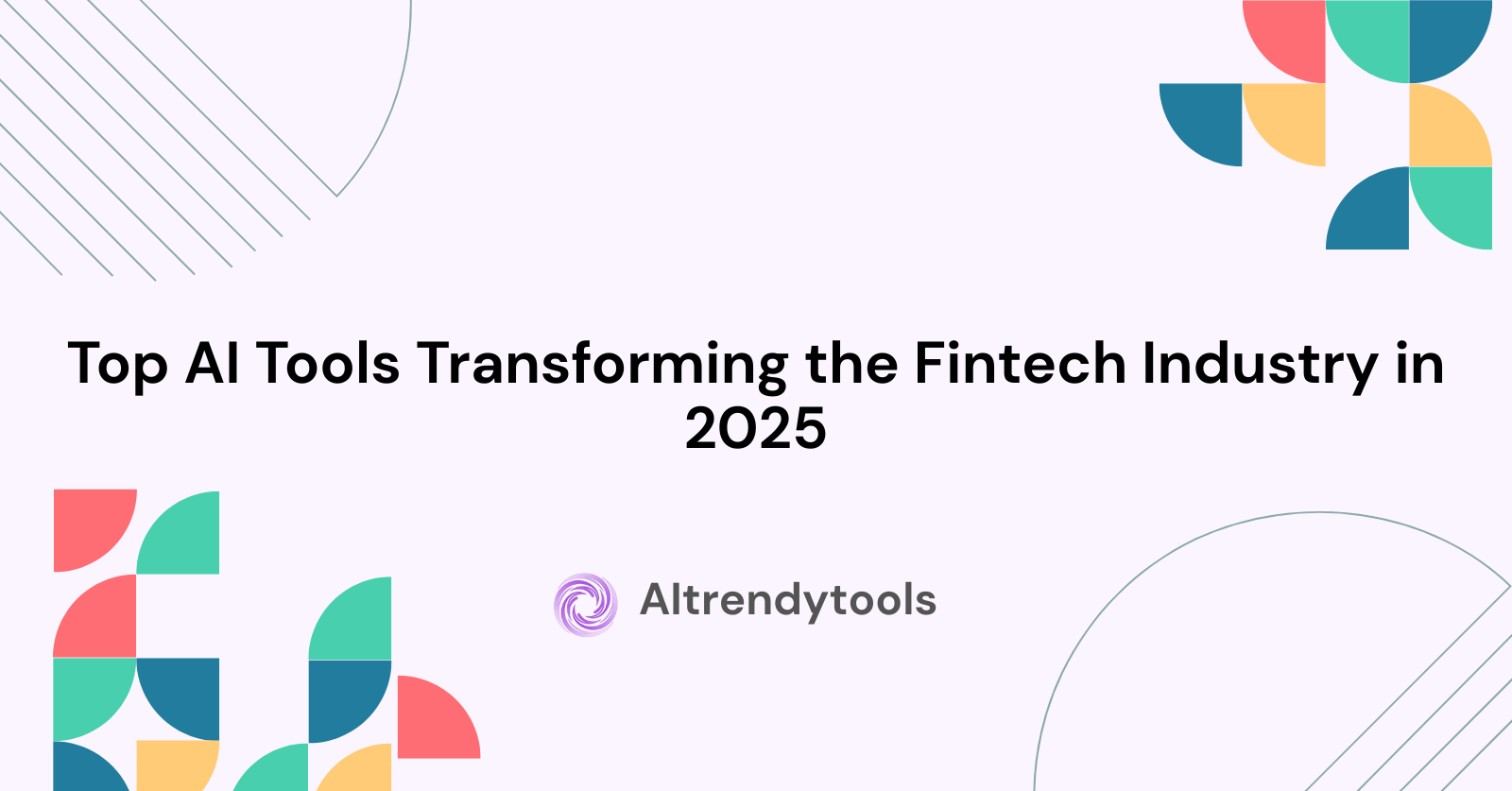🔥 AITrendytools: The Fastest-Growing AI Platform |
Write for usTop AI Tools Transforming the Fintech Industry in 2025
Discover the top AI tools revolutionizing fintech in 2025—from fraud detection and lending to trading, compliance, and personalized banking experiences.
Oct 23, 2025
Finance and tech have always played well together, but AI is taking the relationship to a new level. The way we spend, shop, and manage money is changing faster than ever.
Over the last decade, we’ve gone from rule-based chatbots and simple fraud alerts to entire ecosystems of AI platforms running the show. What once felt cutting-edge now looks quaint compared to the tools banks, lenders, and fintech startups are using today.
AI isn’t a nice add-on anymore; it’s central to strategy. It helps institutions handle rising customer expectations, new regulations, and the push to deliver more services without ballooning costs.
Here’s a look at where AI is making the biggest difference: fraud detection, customer engagement, trading, compliance, operations, cybersecurity, lending, research, and even blockchain.
Smarter Fraud Detection and Risk Analytics
Fraud is one of the biggest money drains in finance, and the old systems just couldn’t keep up. They worked on rules, if X happens, do Y, but fraudsters got around these rules fast. AI changes the game.
These tools watch millions of transactions in real time and catch things you’d never spot manually. Take Feedzai. It uses graph analytics to track transaction flows and spot coordinated fraud rings as they form. And it keeps learning from every case, getting sharper with each pass. Behind the scenes, much of this AI power depends on well-labeled training data — often prepared by a data annotation company working closely with fintech teams to ensure accuracy, security, and compliance.
Darktrace for Finance takes another tack. It builds behavior profiles for customers and flags deviations instantly; say, a sudden transfer abroad or unusual spending. The beauty is, it doesn’t need constant rule updates.
For customers, it means fewer annoying false alarms and better protection. For banks, it means less money lost and a stronger reputation for keeping accounts safe.
The upshot is that banks can step in early, before the fraudsters drain your bank account.
On the lending side, credit scores have always been blunt tools. If you don’t fit the mold, you’re often out of luck. AI changes that by looking at a much bigger picture.
Platforms like Zest AI and Upstart don’t just glance at your FICO. They analyze spending habits, cash flow, even digital activity. That makes it possible to give fairer rates and approve people who would’ve been denied before.
Lenders win because defaults go down. Borrowers win because they finally get access to loans, mortgages, or credit cards they deserve.
Together, these tools push risk management from reactive to proactive. Imagine a situation where you want to identify clients that would make good candidates for loans. In traditional settings, you’d have to focus on one data point to decide who to call.
But what happens when you’ve never offered these clients credit before. How do you know who’s eligible, and if they do qualify, who’s most likely to take up the deal? AI can analyze buying patterns, customer activity on your website, and several other datapoints.
The AI can even start the process off, by creating personalized email campaigns that speak to each individual customer. They can then nurture those leads, passing off the most promising ones to your sales teams.
Personalization at Scale in Customer Engagement
Remember the days of calling your bank and waiting on hold forever, only to explain the same thing three times? That’s fading fast.
AI-powered assistants like Kasisto’s KAI or Google’s Contact Center AI now answer questions instantly and in plain language. They don’t just spit out generic responses either, they remember your goals, like saving for a house, and adjust their advice as you go.
The result? Banking feels less like a transaction and more like a relationship. That builds trust in a way no chatbot from ten years ago ever could.
AI tools today deliver conversations that actually feel personal. SupportYourApp, a professional customer support company specializing in tech and fintech customer support, builds and trains a bot on their customer’s data, so it’s completely customizable. It also learns from each transaction.
Meanwhile, Cognitivescale weaves together fragmented data through its “AI trust fabric,” surfacing next-best actions like suggesting a mortgage to someone preparing for homeownership.
And then there’s Google Cloud’s Contact Center AI, which powers conversations across phone and text. Unlike early chatbots, it picks up on tone and sentiment, adjusting responses on the fly.
The difference? These tools don’t just automate, they make people feel understood, which builds trust and loyalty. They chat with your clients, much like a friend would, at a time convenient to them. This gives them the support they need when they need it, making them feel heard.
And why stop there? What about personalized marketing campaigns to those customers visiting your site? Instead of just showing people the same items that they abandoned in their cart, you can show something similar, or perhaps bring up a helpful snippet of information that helps them make a buying decision.
AI-Powered Trading and Investment Platforms
The market moves on everything: earnings calls, tweets, global news. No human can keep up with that deluge of data, but AI can. And it can do so with the transparency and adaptability that are so important in today’s market.
Tools like AlphaSense sift through reports and filings, while Sentifi tracks news and social chatter across the globe.
Kavout’s Kai Score mixes traditional financial metrics with news sentiment and social chatter, giving portfolio managers a fuller picture.
Wealthfront has added deep learning to its robo-advisor. It doesn’t just balance portfolios, it predicts cash flow needs and shifts allocations as life circumstances change.
Then there’s Numerai Signals, a crowdsourced model where data scientists worldwide contribute algorithms. Numerai combines them into one “meta-model” guiding trades. No single firm owns the edge, it’s collective intelligence at work.
AI-driven trading today isn’t just about speed. It’s about smarter, more adaptive strategies that account for risk and behavior. Instead of replacing analysts or investors, AI gives them sharper insights and more time to focus on strategy.
Compliance and Regulatory AI
Regulations never stop shifting, and the penalties for slipping up are steep. AI tools now do much of the heavy lifting in compliance.
Ayasdi, part of SymphonyAI, is widely used for anti-money laundering. It spots hidden links and networks that older systems missed.
Ascent RegTech takes on regulatory updates, scanning global changes and mapping them directly to business obligations. No more hours of sifting through legal text.
Behavox watches the inside, scanning employee emails, chats, and calls for signs of misconduct or insider trading.
With these platforms, compliance teams work faster, scale oversight without scaling staff, and show regulators they’re on top of things.
Operational Efficiency and Process Automation
Behind every sleek app is a mountain of boring paperwork: loan forms, compliance checks, onboarding steps. AI is clearing that backlog.
UiPath bots can now read and classify documents, not just shuffle data.
Hyperscience is big in loan processing, pulling accurate data from PDFs, scans, and even handwritten forms. What once took days is done in minutes.
WorkFusion automates compliance-heavy tasks like KYC checks, cross-referencing databases and watchlists without human bottlenecks.
That means lower costs for banks, quicker approvals for customers, and employees freed up to tackle real problems instead of typing the same data into three different systems.
Cybersecurity Reinvented by AI
Older systems reacted too slowly. AI adapts in real time, which makes it much harder for criminals to stay ahead. Finance is still the juiciest target for cybercrime, and static defenses just don’t cut it anymore.
You need a system that can monitor all the real-time transactions and highlight any issues. More importantly, you need something that can step in as necessary.
Vectra AI spots attackers already inside networks by flagging unusual traffic.
CrowdStrike Falcon monitors trillions of global events to detect new exploits before they spread.
Sensity AI focuses on deepfakes, making sure banks aren’t fooled by synthetic audio or video during payment or ID checks.
Without these AI shields, fintech’s other innovations wouldn’t survive long.
AI in Lending and Credit Innovation
Traditional credit models left huge gaps. AI is filling them.
Upstart trains its models on thousands of variables, giving borrowers fairer rates and lenders lower risk.
LenddoEFL brings credit access to emerging markets by scoring customers with mobile data and social connections instead of formal histories.
Blend streamlines mortgage applications with automated data collection and verification, cutting time for both sides.
AI lending isn’t about rigid formulas anymore; it’s about nuance and inclusion, without extra risk.
Investment Research and Market Intelligence
Analysts can’t possibly track all the data hitting markets. AI tools make it manageable.
AlphaSense scans filings, transcripts, and research reports, surfacing shifts that others might miss. Sentifi maps how global events ripple across markets by processing millions of articles and posts.
Clarity AI zeroes in on ESG performance, helping funds balance returns with responsible investing.
These tools don’t replace human judgment, but they give analysts a serious boost. They also go one step further and open new markets.
AI isn’t just helping big banks; it’s making finance more accessible in places that were left behind.
Take LenddoEFL. It uses mobile data and social connections to build credit scores for people without traditional credit histories. That’s life-changing for millions of “unbanked” individuals in emerging markets.
By opening access to credit, savings, and payments, AI tools are creating opportunities where the traditional system shut people out.
The Convergence of AI and Blockchain
Two concepts that once lived apart are starting to overlap.
Chainalysis uses AI on blockchain graphs to spot illicit activity faster; crucial for exchanges and regulators.
Fetch.ai is building decentralized AI agents that manage liquidity pools and arbitrage in DeFi markets without human oversight.
This area is still early, but it could define fintech’s next frontier.
Looking Ahead
The big story in 2025 is variety. There isn’t one platform ruling fintech—there are dozens of specialized tools working together.
Feedzai and Zest AI keep fraud in check while expanding credit access. Kasisto and Cognitivescale personalize banking. Kavout and AlphaSense power investment insights. Compliance, cybersecurity, lending, and back-office operations all run smoother thanks to equally sharp AI.
The real challenge now isn’t whether to adopt AI; it’s how to connect it all seamlessly. Institutions that pull that off will thrive. Those chasing flashy point solutions will fall behind.
For customers, this shift means faster approvals, safer transactions, and services that feel tailored. For institutions, it’s survival in a brutally competitive market.
AI isn’t hype anymore. It’s the backbone of modern finance, and its role is only going to grow.
🚀 Submit Your Tool to Our Comprehensive AI Tools Directory
Get your AI tool featured on our complete directory at AITrendytools and reach thousands of potential users. Select the plan that best fits your needs.





Join 30,000+ Co-Founders
Related Blogs
DreamFace: #1 AI Face Generator for Realistic Photos
Discover DreamFace, the leading AI face generator creating ultra-realistic portraits. Free & premium tools for creators, gamers & professionals. Try now!
TechMapz Com: 7 Reasons It's Your Best Tech Hub
Discover TechMapz com the ultimate technology hub for gadget reviews, AI trends, cybersecurity tips, and tech news. Explore features that make it stand out in 2025.
Sci Hub: 10+ Free Alternatives to Access Research Papers
Discover Sci Hub alternatives and 10+ legal ways to access research papers free. Complete guide to scientific journals, open access, and academic resources.
Submit Your Tool to Our Comprehensive AI Tools Directory
List your AI tool on AItrendytools and reach a growing audience of AI users and founders. Boost visibility and showcase your innovation in a curated directory of 30,000+ AI apps.





Join 30,000+ Co-Founders

